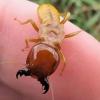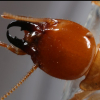Here we go with another episode of "The Termite's Corner"!
This time the species featured is the remarkable Cornitermes cumulans, with a litte cameo of the closely related C. pugnax.
C. cumulans is a termite species haling from the subfamily Syntermitinae, which contains several "mandibulate nasute" genera that sports fascinating soldiers equipped with both an elongated nasus capable of squirting gluey, toxic substances over remarkable distances (like in the subfamily Nasutitermitinae) and prominent, functioning mandibles (in Nasutitermitinae they are always small and vestigial), often very curved in order to pierce large vertebrate predators: Rhynchotermes is probably the best example. Returning to C. cumulans, this species hail from south America, from north-east Brazil to northern Argentina. It's a litter-feeding species that build conspicuous epigeal mound that can be present in huge numbers, in fact is one of the key sightings of the Brazilian Cerrado ecoregion.
This termites sports 3 castes: pimary royals, true workers and soldiers: neotenics are absent here, despite being present in some other Syntermitinae. Workers are very delicate, with thin exoskeleton and large, well-visble guts that give their abdomen a plump appearance. Soldiers are notably larger and more agile, with oversize, armored heads and compact but very sharp mandibles, capable of inflicting a powerful cutting bite. They also employ another weapon: from a tiny tubule on their forehead they can exude a chemical-rich liquid, working in concert with the mandibles and enhancing the effectiveness of their already strong bite. Their one and only purpose is to protect their colony, to the point that they can't even feed themselves and must be cared for by the workers. They are a small minority of the colony, and like the workers they are blind, orienting themselves through chemical and vibrational clues. The queen of a mature colony can achieve a notable physogastry, her abdomen swelling considerably to make space for more and more ovaries: this give them a large reproductive output, and like the king possess well developed compund eyes. Obviously they are accompanied by a very large number of immatures, mainly neanids but also presoldiers and, if in season, nymphs, immature royals already sporting with wing buds.
As said before, they build rather large mounds that can reach heights of 2 meters, though they are usually much smaller. In the Brazilian Cerrado these mound literally dot vast swats of landscape, and are often used by the locals as natural ovens or coocking stoves! The mounds are made of 2 different parts: a reddish, very thick and hard outher shell and a dark colored, combed and more brittle inside that also expand below ground level and house the actual termite population. The mound shell, however, provides a very favourable habitat for particular inquilines: other termite colonies! In fact, only one third of active C. cumulans nests in the Cerrado cointain only the species that built (or rarely reoccupied) it, and in some cases up to 5 termite species can be found in the same termitary! It should be noted, however, that this are just inquilines, and the mound-owner will react aggressively to them in case of contact. Ants can also inhabit these nests. Despite its fortress and soldiers Cornitermes is very nutritious (like other termites) and have its predators to face: very damaging ones are the giant anteaters (Myrmecophaga tridactyla) and armadillos, with the latter doing worst damage to the nest by boring large holes at the base: these animals can consume large number of termites and, maybe even more importantly, heavily damage the mound, and here is when ants always come in. They are quite ineffective agaisnt a solid Cornitermes mound: it's very difficult to penetrate, and when finding small passages the intruders will be quickly faced with a formidable and tight wall of armored heads and chopping jaws. Even when relatively small breaches occur these are quickly lined with soldiers and repaired by worker shortly after; however the work of a large myrmecophagous mammal can cause such damage that the termite workers would need a lot of time to seal off all the exposed chambers and galleries, and the soldiers will likewise be unable to form a organized perimeter quickly. Ants are extremely swift to capitalize on this and will attack admist the confusion, targeting the scrambling workers (and less often soldiers) left in and around the rubbles, in addition of course of the defenseless, exposed and probably tasty neanids. In addition, such a breach will be deleterious to the fine condition of humidity and temperature inside the termitarium, a fact that will be particularily dangerous for the youngs. In the worst scenario, especially in the case of an armadillo boring through the mound, the very soft and fragile queen could end up killed and this will probably (though not surely) spell the end of the whole colony, leaving their mound vacant for other termites and ants to occupy. An anteater attack is the kind of situation when having some other termite inquiline could actually be useful, namely the Velocitermes and their nasute soldiers, which seems to have a repellent effect on such predator. Of course many animals of various size find refuge in such hardy and abundant structures, be they active or devoid of the builders: from spiders to birds, from mammals to reptiles, and of course a truly numerous host of small, soil-dwelling invertebrates.
Apart for the aforementioned "culinary" uses of these mounds, they can also be a tourist attraction, especially during the humid nights during the first rains on the Cerrado: during these nights, the mound that dot the landscape are dottet themselves with a multitude of glowing, bright green spots: these are a myriad of carnivorous firefly larvae of the species Pyrearinus termitilluminans (the name speaks for itself) that light the night in the hope of attracting phototaxic insects to prey upon, including termite swamers when available. Adult fireflies brings these bright lights to the air, making for a truly breathtaking scenery!
And now a pair of pic by Doctor Jan Sobotnik, of the Czech University of Life Sciences of Prague:

Here we can clearly see the internal structures of a Cornitermes cumulans mound, and how the red, sound cover contrast with the dark insides, the colony's true home. The many white specimens around are confused neanids, immature termites.

These are indivuduals of the aforementioned Cornitermes pugnax, whose morphology is easily comparable to C. cumulans: note the soft workers with plump, dark abdomens and the soldier, sporting a large armored head full of muscles to move the compact but very sharp mandibles and a minute tubule on the forehead to expel his defensive secretions.
Do you liked this small fellows? I do! So, to next time with another species!























